Clay pot glass noodles are easy to prepare and yield a result that feels unmatched to the minimal effort the meal takes to create. In Thai eating habits, this is one of the rare times in which the world of rice and noodles meet; this dish is part of the gap khao, or foods eaten with rice, repertoire and is hence suitable to serve tao hoo op woon sen with jasmine rice.
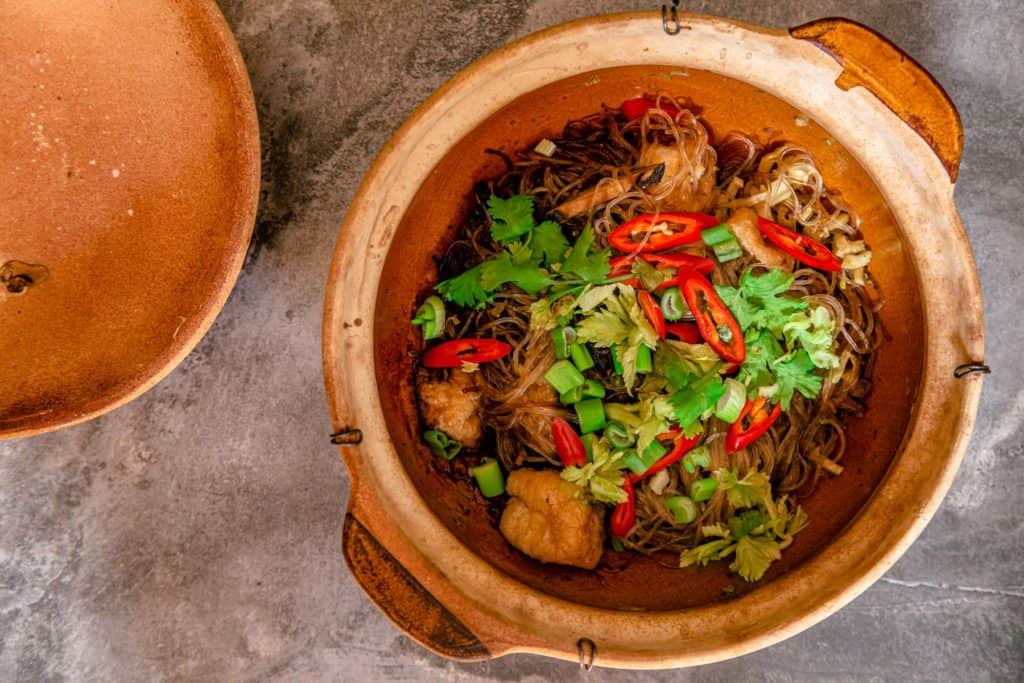
Found in most East and SE Asian shops, glass noodles are typically packaged in small bundles tied together with string. Also called cellophane noodles, bean thread noodles, woon sen (in Thai), glass noodles, and mung bean noodles, these starchy strands are sturdy in their dried form but made easily pliable by a short soaking period. Look for packets where the only ingredients are mung bean starch (and maybe water).
In Thai this dish is called tao hoo op woon sen. Here is a quick breakdown of the title:
- tao hoo means tofu.
- op means baked even though this dish is traditionally cooked on fire or coal (over a specific type of clay charcoal oven called a tao, which easily bestows fire). Flames licking the sides of the cooking vessel are imagined to created an ovenlike effect.
- woon sen means glass noodles in Thai language.
Clay pot glass noodles is a dish of chinese origin, but over time the Thai palate demanded and made adjustments. The sam glueur base of coriander root (substituted with coriander stem in this recipe) + garlic + white pepper is a prime example of such modification.
📖 Recipe
Clay pot glass noodles with tofu (tao hoo op woon sen – เต้าหู้อบวุ้นเส้น)
Ingredients
- 1-2 dried shiitake mushrooms
- 50 grams glass noodles
- 60 millilitres stock, water or shiitake soaking water (¼ cup)
- 1 tablespoon mashed fermented white tofu see notes1
- 1 ½ teaspoons vegan oyster/mushroom sauce
- 1 teaspoon shaoxing rice wine
- 1 teaspoon thin soy sauce see notes2
- 1 teaspoon seasoning sauce see notes2
- ¾ teaspoon black soy sauce see notes2
- ½ teaspoon sugar
- 2 teaspoons chopped coriander stem
- 1 large clove garlic
- 5 grams peeled ginger (1-2 slices)
- Generous pinch or two ground white pepper
- Generous pinch of two toasted and ground sichuan peppercorn (optional)
- 2 teaspoons vegetable or sesame oil or a blend
- 2-3 tofu puffs halved into triangles
- Asian celery
- Spring onion
- Coriander leaves
- Sliced long red chilli
Instructions
- Place the dried mushrooms in a separate bowl and cover with hot water to soak for 20 minutes or until soft. When the mushrooms are soft, squeeze them out and slice. Save the soaking water (use any extra for a future gravy base or stock).
- Place the glass noodles in a bowl and cover with warm water to soak for 20 minutes. Strain water away and return noodles to bowl. Add the water or mushroom soaking water, along with the fermented tofu, vegan oyster sauce, rice wine, thin soy sauce, seasoning sauce, black soy sauce, and sugar. Toss through the noodles and set aside.
- Using a pestle and mortar, pound the coriander stem, garlic, ginger, white pepper, and sichuan peppercorn (if using) together into a rough paste.
- Heat the oil in a clay pot or saucepan over medium heat and saute the paste until fragrant and a shade or two darker. Turn the heat down to medium low and pour in the seasoning water. Stir to blend paste and liquid. Add tofu puffs and mushrooms, followed by the noodles. Give everything a little push with a spoon so the noodles are mostly covered in liquid. Pop the lid of the clay pot or saucepan back on.
- After a couple of minutes, shuffle the noodles to evenly distribute the sauce. Place the lid back on and cook for 5-10 minutes until the noodles are done. Top with fresh herbs and chilli slices to serve.
Notes
- Fermented tofu is available in red and white varieties. The former tends to be sold in ceramic containers (and there is one brand available in can), while the latter typically comes in small glass jars. At a larger Asian market the variety of fermented white bean curd can seem overwhelming, but whatever you get will work okay in this recipe. You'll find it in just about any Chinese market.
- Check out my guide to Thai soy and seasoning sauces if you're not sure what these are.

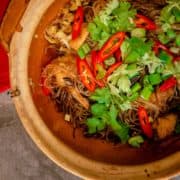
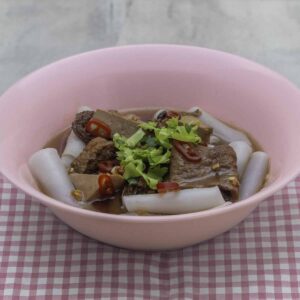
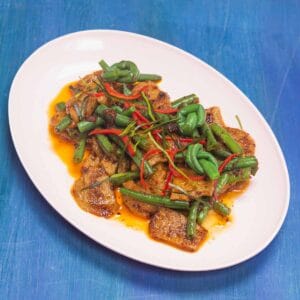
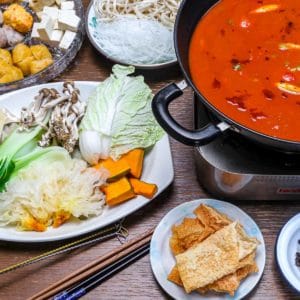
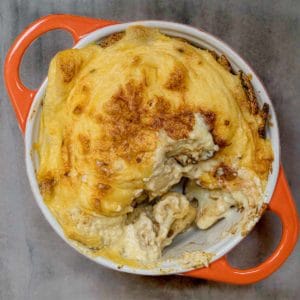
Desicart says
Nice blog to follow while preparing recipes.Thank you so much for sharing with us.
I reserve the right to improve malicious and trollish comments.